Observation and Analysis of Deformation Control Performance of Hydraulic Servo Steel Support for a Soft Soil Pit—A Case Study of a Pit Project in Hangzhou
Abstract
1. Introduction
2. Project Background and Monitoring Plan
2.1. Project Background
2.2. Geological and Hydrogeological Conditions of the Site
2.3. Excavation Scheme and Monitoring Plan
2.3.1. Excavation Scheme
2.3.2. Monitoring Plan
3. Results and Analysis
3.1. Horizontal Displacement of the Retaining Structure
3.2. Horizontal Displacement of Soil
3.3. Axial Force of the Support Structure
4. Discussion
4.1. Effectiveness of the HSSS
4.1.1. Prestressing Application Scheme
4.1.2. Effectiveness of the Hydraulic Servo Steel Supports
4.1.3. Design Adjustment and Optimization Suggestions
4.2. Limitations and Prospects
5. Conclusions and Recommendations
- (1)
- Statistical analysis establishes that HSSS implementation achieves dual improvement in both deformation magnitude control and measurement reliability for foundation pit retaining structures. The horizontal displacements (δD) in conventional configurations ranged from 0.23 to 0.78%H (μ = 0.38%H, 95% CI = 0.30–0.44%H), indicating both higher deformation magnitudes and greater data dispersion. In contrast, HSSS-reinforced structures exhibited significantly constrained δD values of 0.05–0.18%H (μ = 0.11%H, 95% CI = 0.09–0.13%H), representing a 71% mean reduction with enhanced measurement precision
- (2)
- When employing a three-layer HSSS for a foundation pit with a depth of 12.55 m, the maximum displacements during the excavation and dismantling stages were controlled within 6 mm and 17 mm, respectively.
- (3)
- The displacement variability of the soil outside the foundation pit was greater than that of the retaining structure.
- (4)
- The application or removal of the internal supports within the foundation pit influenced the axial force, resulting in strain occurring in the first-layer supports.
- (1)
- During the engineering design process, the use of servo jacks is usually calculated based on ordinary prestressed support, and the adjustment of the axial force using the HSSS should also be included in the calculations.
- (2)
- The design should take into account the dynamic adjustment of axial forces during the excavation and HSSS removal stages to improve deformation control.
- (3)
- In the calculations for support removal, the support stiffness should not be assumed to be infinite; instead, it should be calculated based on the specific structure. Additionally, back analysis can be performed on monitoring data and key parameters. A substantial amount of data can also be summarized to provide empirical parameters for future projects.
Author Contributions
Funding
Data Availability Statement
Conflicts of Interest
References
- Gong, X.N. Construction Design Manual of Deep Excavation; China Architecture & Building Press: Beijing, China, 1998. (In Chinese) [Google Scholar]
- Zeng, C.-F.; Liao, H.; Xue, X.-L.; Long, S.-C.; Luo, G.-J.; Diao, Y.; Li, M.-G. Responses of groundwater and soil to dewatering considering the barrier effect of adjacent metro station on multi-aquifers. J. Hydrol. 2022, 612, 128117. [Google Scholar] [CrossRef]
- Wang, W.D.; Shen, J.; Hu, Y. Design and practice of safety and environmental control for super large area foundation pit group project in soft soil areas. Build. Struct. 2024, 54, 30–40. [Google Scholar]
- Yang, K.F.; Xu, C.J.; Chi, M.L.; Wang, P. Analytical analysis of the groundwater drawdown difference induced by foundation pit dewatering with suspended waterproof curtain. Appl. Sci. 2022, 12, 10301. [Google Scholar] [CrossRef]
- Li, M.-G.; Zhang, Z.-J.; Chen, J.-J.; Wang, J.-H.; Xu, A.-J. Zoned and staged construction of an underground complex in Shanghai soft clay. Tunn. Undergr. Space Technol. 2017, 67, 187–200. [Google Scholar] [CrossRef]
- Zheng, G. Deformation control methods and engineering applications of foundation pit engineering in soft soil areas. Chin. J. Geotech. Eng. 2022, 44, 1–36. [Google Scholar]
- Wang, W.D. Analysis methods and control technologies for deformation and environmental impact of deep foundation pits in soft soil. Chin. J. Geotech. Eng. 2024, 46, 1–25. [Google Scholar]
- Cheng, X.S.; Zhen, J.; Zheng, G.; Wang, Z.Y.; Wang, Z.; Song, X.G. Study on the sliding radius of stability failure at the bottom of foundation pits in soft soil areas. J. Archit. Civ. Eng. 2021, 38, 90–97. [Google Scholar]
- Ou, C.Y.; Teng, F.C.; Wang, I.W. Analysis and design of partial ground improvement in deep excavations. Comput. Geotech. 2008, 35, 576–584. [Google Scholar] [CrossRef]
- Zeng, F.-Y.; Zhang, Z.-J.; Wang, J.-H.; Li, M.-G. Observed performance of two adjacent and concurrently excavated deep foundation pits in soft clay. J. Perform. Constr. Facil. 2018, 32, 1–13. [Google Scholar] [CrossRef]
- Lin, G.; Lin, Z.; Zhao, Y.; Xu, C.; Sun, F.; Duan, Y.; Fang, T. Force and deformation characteristics of large-scale zoning excavation in soft soil: A case study in Hangzhou. Appl. Sci. 2024, 14, 6358. [Google Scholar] [CrossRef]
- Huang, D.M.; Huang, X. Application research of steel support axial force servo system in foundation pit deformation control. Build. Struct. 2020, 50 (Suppl. S1), 1069–1074. [Google Scholar]
- Gu, H.L.; Deng, X.Z.; Xu, B.G.; Di, H.G.; Jin, Y.Y.; Fan, X.Y. Design and effect analysis of staged axial force for servo steel support in foundation pits. Urban Rapid Rail Transit 2023, 26, 31–37. [Google Scholar]
- Zheng, X.; Tang, J.X.; Cheng, Y.C.; Gong, D.K.; Lan, J.Z. Measured analysis of the impact of deep foundation pit construction of metro stations on adjacent buildings in soft soil areas. Build. Struct. 2021, 51, 128–134. [Google Scholar]
- Fang, Y.L.; Lu, Z.R.; Wang, J.; Fu, Q.; Zi, X.Y.; Lian, Z. Research on safety support technology for ultra-deep foundation pits based on servo support combination systems. Tunn. Constr. 2019, 39 (Suppl. S2), 120–128. [Google Scholar]
- Moormann, C. Analysis of wall and ground movements due to deep excavations in soft soil based on a new worldwide database. J. Jpn. Geotech. Soc. 2004, 44, 87–98. [Google Scholar] [CrossRef]
- Hou, X.Y.; Chen, Y.F. Calculation of ground settlement caused by deep excavation. Geotech. Eng. 1989, 1, 13. [Google Scholar]
- Wang, W.D.; Xu, Z.H.; Wang, J.H. Statistical analysis of ground surface deformation characteristics around deep foundation pits in Shanghai. Chin. J. Geotech. Eng. 2011, 33, 8. [Google Scholar]
- Tan, Y.; Kang, Z.J.; Wei, B. Case study of a deep foundation pit for a metro ventilation shaft in Shanghai soft soil area. J. Zhejiang Univ. (Eng. Sci.) 2016, 50, 830. [Google Scholar]
- Wu, C.J.; Sun, Z.H.; Lai, Y.J.; Bao, H. Deformation characteristics of deep and large foundation pits with diaphragm walls in soft soil areas. Rock Soil Mech. 2018, 39 (Suppl. S2), 9. [Google Scholar]
- Zhu, J.C.; Zhu, Y.H.; Wang, X.; Zhou, Q.J. Study on deformation characteristics of ultra-deep foundation pits in Hangzhou soft soil. J. Undergr. Space Eng. 2018, 14 (Suppl. S2), 335–341. [Google Scholar]
- Yang, Y.H.; Wang, J.J.; Wu, J.G.; Li, C.S. Monitoring analysis of informationized construction of deep foundation pits at Qiutao Road Station of Hangzhou Metro. Chin. J. Geotech. Eng. 2008, 30, 1550–1554. [Google Scholar]
- Tang, X.L. Research on Deformation Control of Support by Steel Support Axial Force Servo System in Deep Metro Foundation Pits. Master’s Thesis, East China Jiaotong University, Nanchang, China, 2023. [Google Scholar]
- Huang, B.; Li, M.G.; Hou, Y.M.; Chen, J.J. Study on the influence of axial force self-compensating support on the stress and deformation of retaining structures. Rock Soil Mech. 2018, 39 (Suppl. S2), 359–365. [Google Scholar]
- Li, M.G.; Demeijer, O.; Chen, J.J. Effectiveness of servo struts in controlling excavation-induced wall deflection and ground settlement. Acta Geotech. 2020, 15, 2575–2590. [Google Scholar] [CrossRef]
- Lim, A.; Ou, C.Y.; Hsieh, P.G. Investigation of the integrated retaining system to limit deformations induced by deep excavation. Acta Geotech. 2017, 13, 973–995. [Google Scholar] [CrossRef]
- Xu, C.J.; Yang, K.F.; Fan, X.Z.; Ge, J.J.; Jin, L. Numerical investigation on instability of buildings caused by adjacent deep excavation. J. Perform. Constr. Facil. 2021, 35, 04021040. [Google Scholar] [CrossRef]
- Ding, H.; Wan, Q.; Xu, C.; Fan, X.; Tong, L. Semianalytical method for controlling the deformation of retaining structures subjected to asymmetrical loads. Int. J. Geomech. 2024, 24, 04024031. [Google Scholar] [CrossRef]
- Feng, G.; Xu, C.; Ding, Z.; Liang, L.; Li, Y.; Fan, X. Improved analytical solution for forecasting overlying excavation-induced tunnel response. Transp. Geotech. 2023, 43, 101142. [Google Scholar] [CrossRef]
- Feng, G.; Xu, C.; Ding, Z.; Tey, M.; Cao, Z.; Liang, L.; Fan, X.; Yang, K. Enhanced theoretical approach for predicting the tunnel response due to deep excavation above. Transp. Geotech. 2024, 48, 101309. [Google Scholar] [CrossRef]
- Di, H.; Jin, Y.; Zhou, S.; Zhang, X.; Wu, D.; Guo, H. Experimental study on the adjustments of servo steel struts in deep excavations. Acta Geotech. 2023, 18, 6615–6629. [Google Scholar] [CrossRef]
- Chen, B.; Yan, T.; Song, D.; Luo, R.; Zhang, G. Experimental investigations on a deep excavation support system with adjustable strut length. Tunn. Undergr. Space Technol. 2021, 115, 104046. [Google Scholar] [CrossRef]
- Xu, C.J.; Chen, Q.; Wang, Y.; Hu, W.; Fang, T. Dynamic deformation control of retaining structures of a deep excavation. J. Perform. Constr. Facil. 2016, 30, 04015071. [Google Scholar] [CrossRef]
- Fan, X.Z.; Xu, C.J.; Liang, L.J.; Yang, K.F.; Chen, Q.Z.; Feng, G.H.; Zhang, J.Z. Experimental and numerical study of braced retaining piles with asymmetrical excavation. Int. J. Civ. Eng. 2024, 22, 1339–1356. [Google Scholar] [CrossRef]
- Lin, Z.; Jiang, Y.; Xiong, Y.; Xu, C.; Guo, Y.; Wang, C.; Fang, T. Analytical solution for displacement-dependent active earth pressure considering the stiffness of cantilever retaining structure in cohesionless soil. Comput. Geotech. 2024, 170, 106258. [Google Scholar] [CrossRef]
- Chen, J.M.; Di, H.G.; Wu, Q.; Chen, J.; Lin, D.; Zhou, X.; Lin, R. Optimization analysis of layout and construction sequence of servo steel supports in deep foundation pits in soft soil. Urban Rapid Rail Transit 2022, 25, 156–161. [Google Scholar]
- Huang, Z.J.; Tang, X.L.; Hou, S.L.; He, X.; Xu, C.; Ding, H. Application and optimization research of standard section servo steel supports in deep foundation pits. Build. Struct. 2023, 53 (Suppl. S2), 2536–2542. [Google Scholar]
- Huang, Z.J.; Tang, X.L.; Peng, J.R.; Ding, H.B.; Chen, Y.G.; Yu, Y.T.; Chen, C.J. Application and optimization research of steel support servo systems in deep foundation pits. Highway 2024, 69, 406–415. [Google Scholar]
- Sun, J.C.; Bai, T.H. Research on the setting method of steel support axial force servo systems in metro foundation pits. J. Undergr. Space Eng. 2019, 15 (Suppl. S1), 195–204. [Google Scholar]
- Cao, H.; Sun, J.C. Research on the determination method of axial force for steel support servo systems in soft soil foundation pits. Build. Constr. 2019, 41, 754–758. [Google Scholar]
- Cao, X.S.; Lu, X.Y.; Gu, Y.M. Study on the variation law of axial pressure of internal steel supports in deep foundation pits. Chin. J. Geotech. Eng. 2022, 44, 1988–1997. [Google Scholar]
- Huang, B.; Li, M.G.; Chen, J.J.; Hou, Y.M.; Wang, J.H. An improved beam-spring model for excavation support. In Proceedings of the China-Europe Conference on Geotechnical Engineering; Springer Nature: Cham, Switzerland, 2018; pp. 336–339. [Google Scholar]
- Yu, Q.Q.; Wang, L.F.; Yang, K.F.; Chen, Q.H.; Feng, L.P. Calculation and analysis of axial force in foundation pit supports. Bull. Sci. Technol. 2019, 35, 181–186. [Google Scholar] [CrossRef]
- Huang, Y.J.; Yuan, S.; Wang, C.; Chen, B.G.; Zhang, Y.L. Theoretical analysis of displacement and axial force of retaining structures under dynamic adjustment of internal support systems. Tunn. Constr. 2023, 43, 761–769. [Google Scholar]
- Zhejiang Provincial Department of Housing and Urban-Rural Development. Technical Code for Foundation Pit Engineering in Zhejiang Province (DB33/T 1096-2014); Zhejiang Provincial Construction Press: Hangzhou, China, 2014. [Google Scholar]

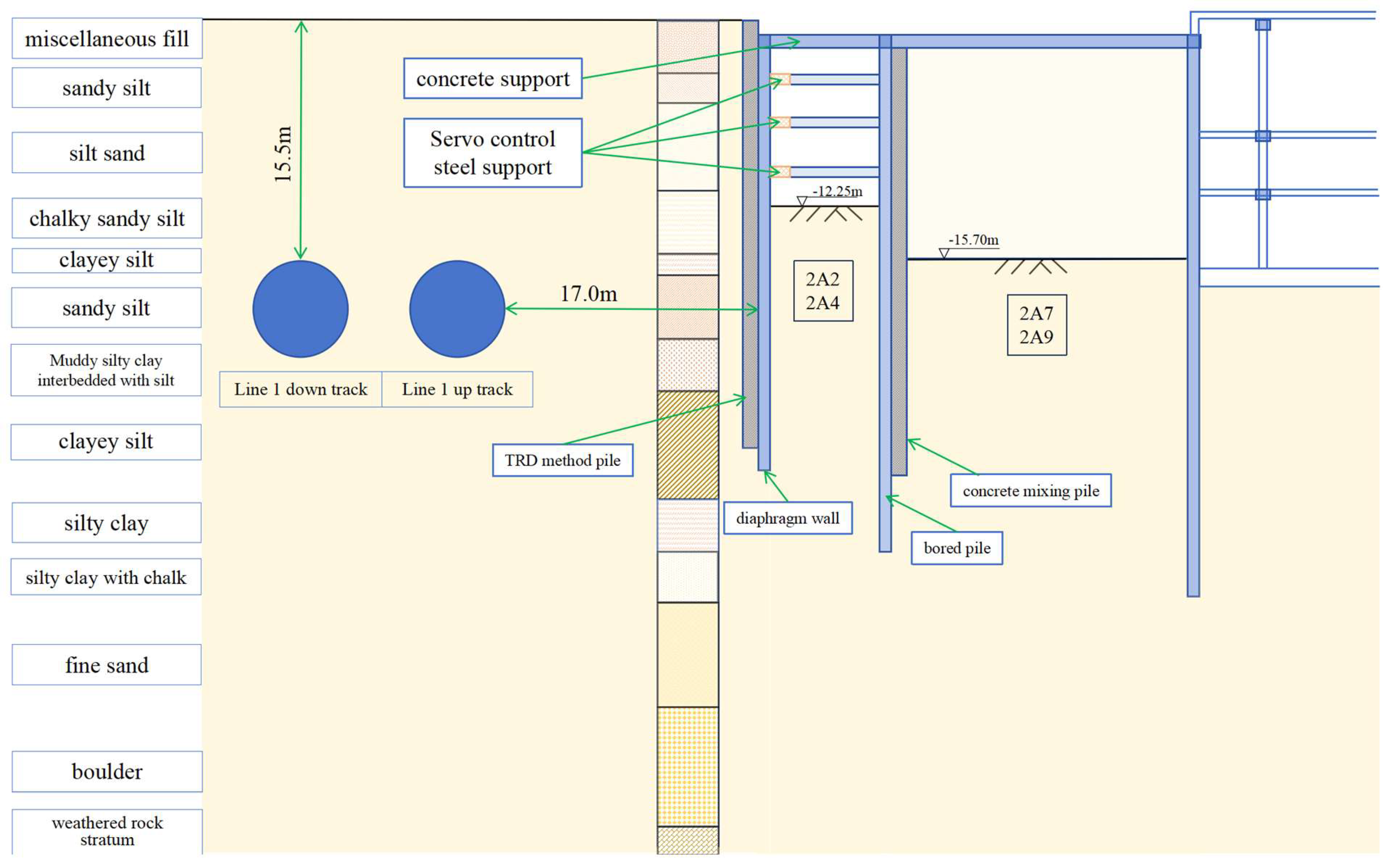

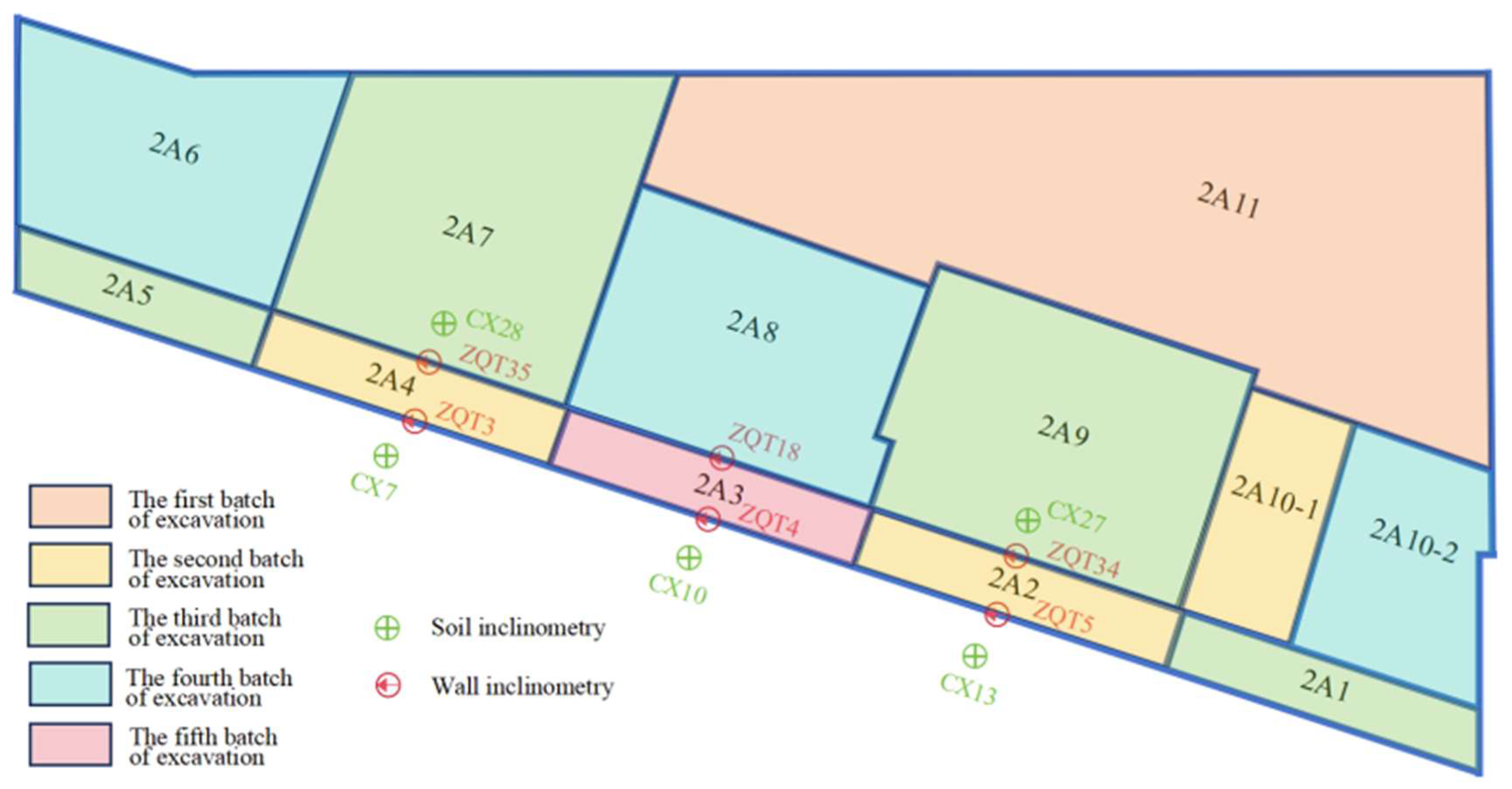


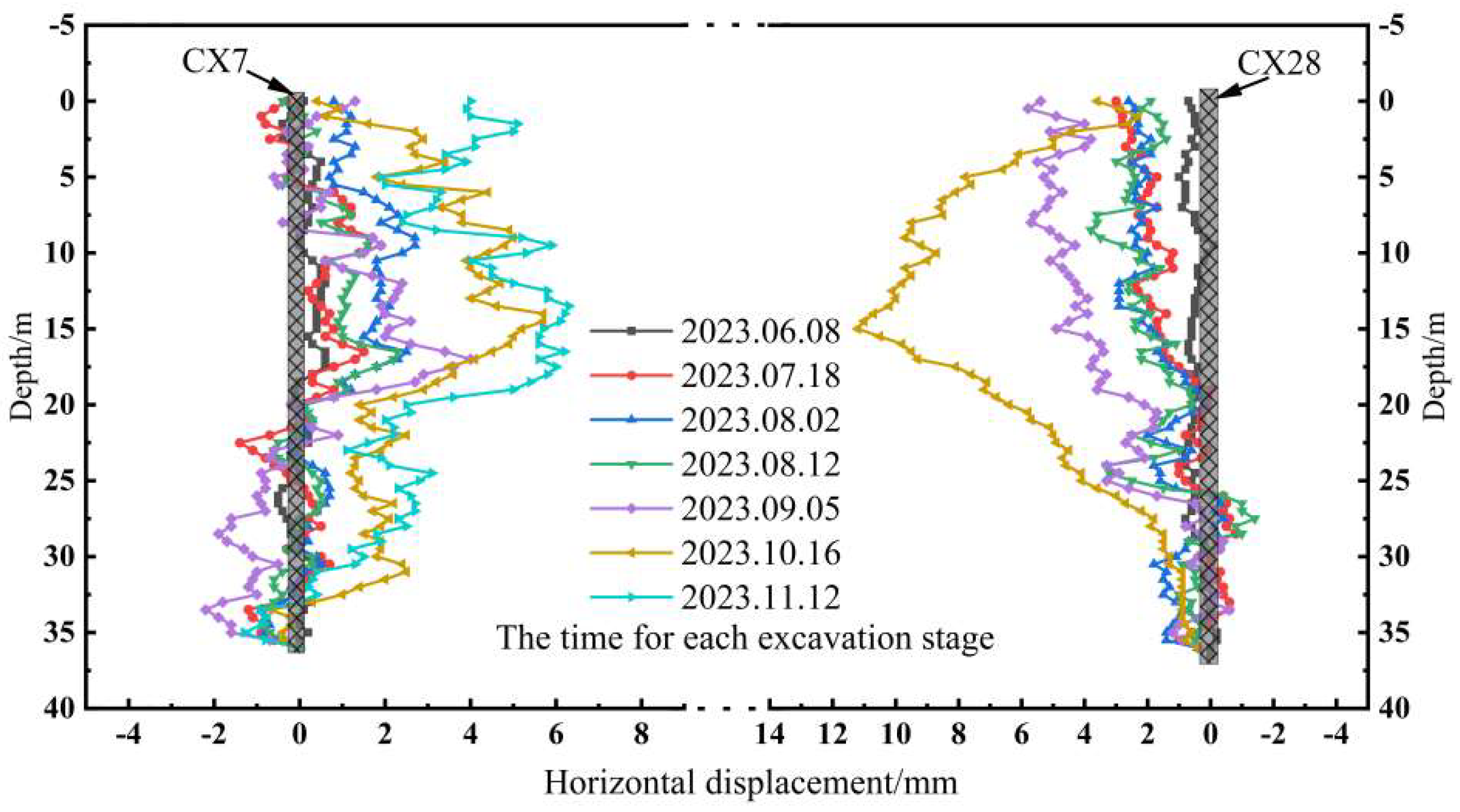
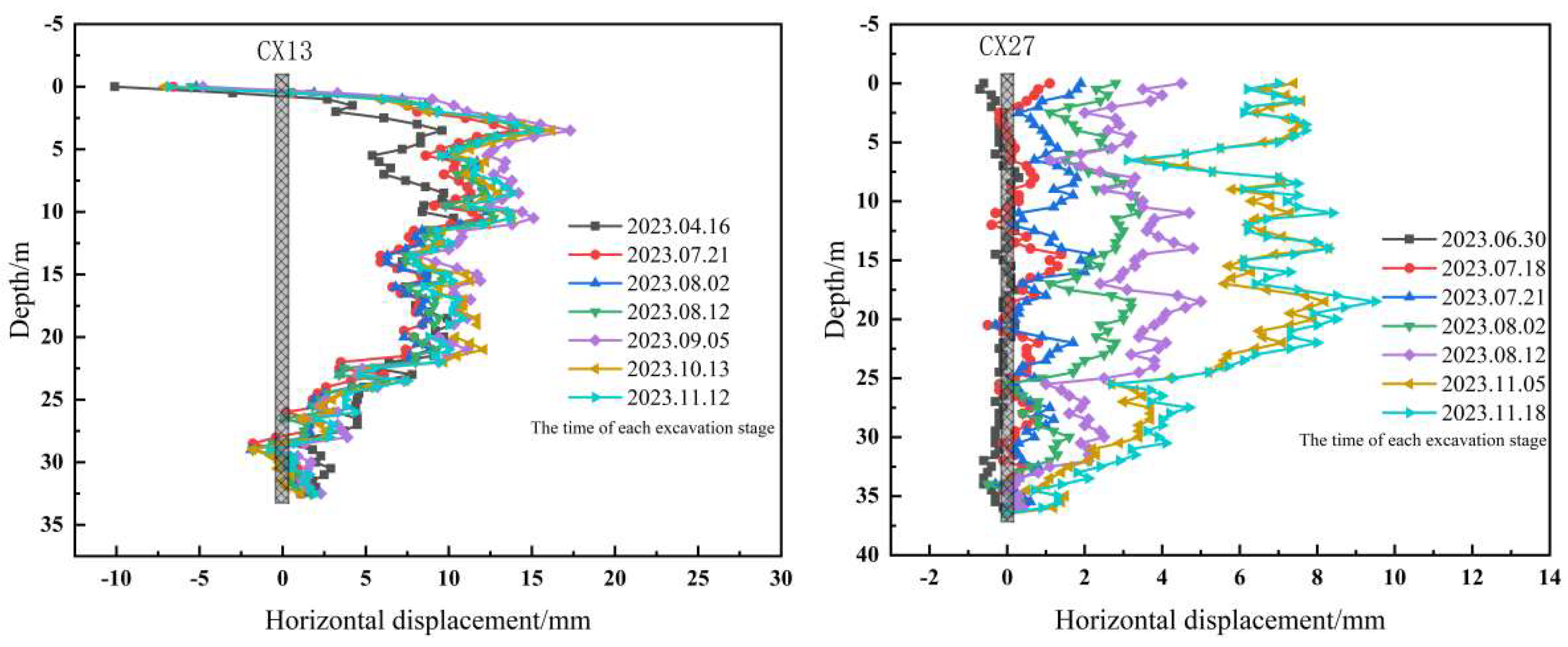

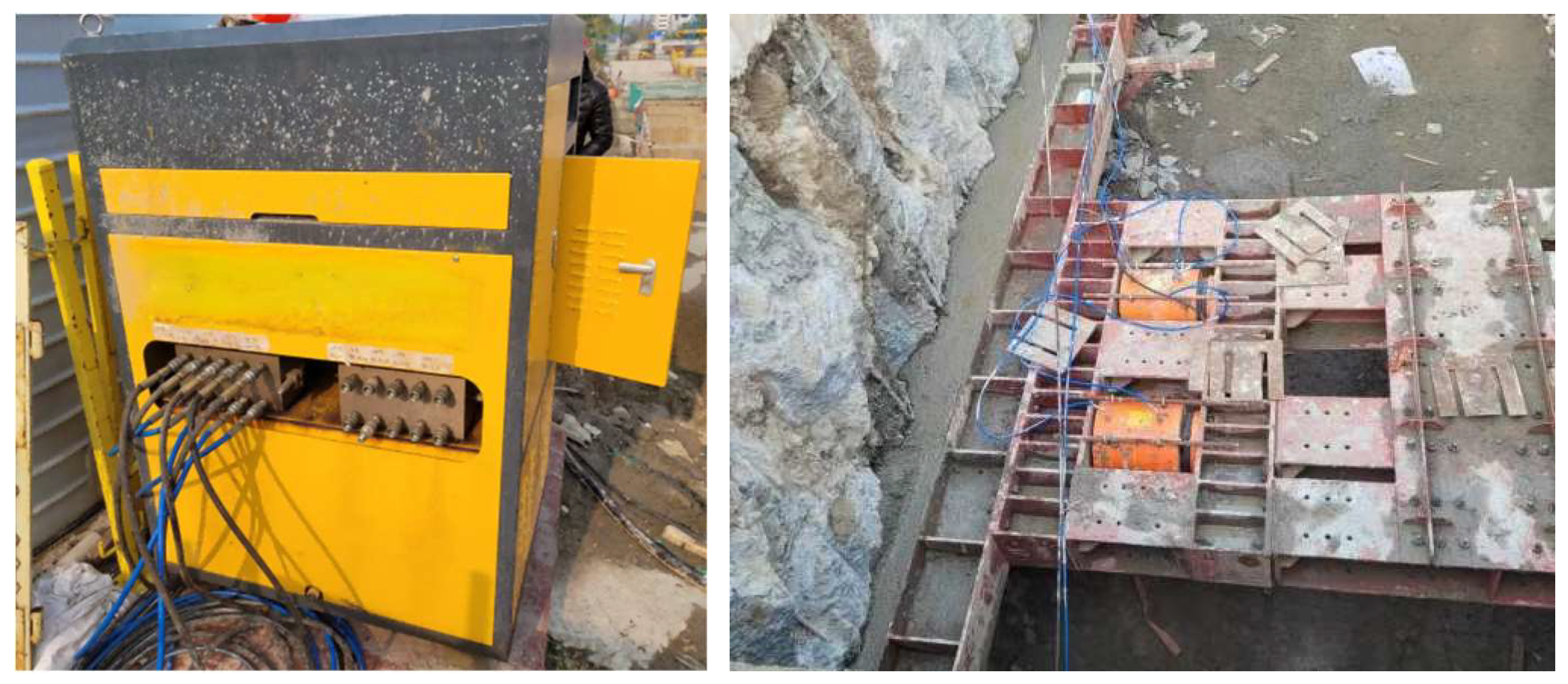
| Batch Number | Zone Number | Excavation Depth (m) | Support Structure |
|---|---|---|---|
| Batch 1 | 2A11 | 17.55 | 3 layers of concrete |
| Batch 2 | 2A2, 2A4, 2A10-1 | 12.55 | 1 layer of concrete + 3 layers of servo steel struts |
| Batch 3 | 2A1, 2A5 | 12.55 | 1 layer of concrete + 2 layers of servo steel struts |
| 2A7, 2A9 | 16.00 | 1 layer of concrete + 3 layers of servo steel struts | |
| Batch 4 | 2A6, 2A8, 2A10-2 | 16.00–16.50 | 1 layer of concrete + 3 layers of servo steel struts |
| Batch 5 | 2A3 | 12.55 | 1 layer of concrete + 2 layers of servo steel struts |
| No. | Soil Layer Name | γ (KN/m3) | c (kPa) | φ (°) | ES (Mpa) |
|---|---|---|---|---|---|
| ① | Miscellaneous Fill | 17.5 | 8 | 10 | 4.0 |
| ② | Sandy Silt | 18.9 | 6.3 | 32.6 | 8.0 |
| ③ | Silt | 19.5 | 3.7 | 36.6 | 14.0 |
| ④ | Silty Clay | 18.7 | 9.1 | 27.4 | 6.0 |
| ⑤ | Silty Clay | 18.3 | 28.4 | 15.8 | 5.0 |
| ⑥ | Silty Clay with Silt | 19.3 | 30 | 21.9 | 11.5 |
| ⑦ | Rounded Gravel | 20 | 3 | 40 | 30.0 |
| ⑧ | Cobbles | 20 | 3 | 42 | 35.0 |
| ⑨ | Strongly Weathered Tuff | 22 | 35 | 25 | 38.0 |
| ⑩ | Moderately Weathered Tuff | 24 | 200 | 32 | 50.0 |
| CX7 | ZQT3 | ZQT35 | CX28 | ||||
|---|---|---|---|---|---|---|---|
| Excavated to Bottom | Support Removal Completed | Excavated to Bottom | Support Removal Completed | Excavated to Bottom | Support Removal Completed | Excavated to Bottom | Support Removal Completed |
| 4 mm | 7 mm | 6 mm | 12 mm | 4 mm | 10 mm | 5 mm | 12 mm |
| CX3 | ZQT5 | ZQT34 | CX27 | ||||
|---|---|---|---|---|---|---|---|
| Excavated to Bottom | Support Removal Completed | Excavated to Bottom | Support Removal Completed | Excavated to Bottom | Support Removal Completed | Excavated to Bottom | Support Removal Completed |
| 14 mm | 17 mm | 8 mm | 11 mm | 6 mm | 12 mm | 5 mm | 10 mm |
| Area | Specific Location | Cross-Sectional Area (mm²) | Initial Force (kN) | Lower Limit of Adjustment Range (kN) | Upper Limit of Adjustment Range (kN) | Alarm Axial Force (kN) |
|---|---|---|---|---|---|---|
| 2A2 2A4 | Second Stage | 438 | 2400 | 2200 | 4400 | 5000 |
| Third Stage | 438 | 3600 | 3400 | 4800 | 6000 | |
| Fourth Stage | 876 | 5200 | 4800 | 8800 | 10,000 | |
| 2A3 | Second Stage | 438 | 2400 | 2200 | 4400 | 5000 |
| Third Stage | 876 | 4800 | 4400 | 8800 | 10,000 |
Disclaimer/Publisher’s Note: The statements, opinions and data contained in all publications are solely those of the individual author(s) and contributor(s) and not of MDPI and/or the editor(s). MDPI and/or the editor(s) disclaim responsibility for any injury to people or property resulting from any ideas, methods, instructions or products referred to in the content. |
© 2025 by the authors. Licensee MDPI, Basel, Switzerland. This article is an open access article distributed under the terms and conditions of the Creative Commons Attribution (CC BY) license (https://creativecommons.org/licenses/by/4.0/).
Share and Cite
Wang, C.; Lin, G.; Yao, H.; Ding, H.; Tang, X.; Lin, Z.; Wang, X. Observation and Analysis of Deformation Control Performance of Hydraulic Servo Steel Support for a Soft Soil Pit—A Case Study of a Pit Project in Hangzhou. Buildings 2025, 15, 1002. https://doi.org/10.3390/buildings15071002
Wang C, Lin G, Yao H, Ding H, Tang X, Lin Z, Wang X. Observation and Analysis of Deformation Control Performance of Hydraulic Servo Steel Support for a Soft Soil Pit—A Case Study of a Pit Project in Hangzhou. Buildings. 2025; 15(7):1002. https://doi.org/10.3390/buildings15071002
Chicago/Turabian StyleWang, Chao, Gang Lin, Hongliang Yao, Haibin Ding, Xiaolin Tang, Zhaorui Lin, and Xuepeng Wang. 2025. "Observation and Analysis of Deformation Control Performance of Hydraulic Servo Steel Support for a Soft Soil Pit—A Case Study of a Pit Project in Hangzhou" Buildings 15, no. 7: 1002. https://doi.org/10.3390/buildings15071002
APA StyleWang, C., Lin, G., Yao, H., Ding, H., Tang, X., Lin, Z., & Wang, X. (2025). Observation and Analysis of Deformation Control Performance of Hydraulic Servo Steel Support for a Soft Soil Pit—A Case Study of a Pit Project in Hangzhou. Buildings, 15(7), 1002. https://doi.org/10.3390/buildings15071002





